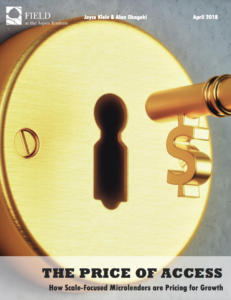 The Price of Access: How Scale-Focused Microlenders are Pricing for Growth
The Price of Access: How Scale-Focused Microlenders are Pricing for Growth
Joyce Klein and Alan Okagaki for FIELD at the Aspen Institute
First published April 2018
As US microlenders have worked to develop business and revenue models that can support larger scale and impact, they have carefully considered the role of pricing. Most microfinance institutions (MFIs) working to aggressively expand their ability to deliver responsibly structured and underwritten loans have found that charging higher interest rates (averaging between 12 and 16 percent across their entire microloan portfolios) is essential to their ability to deliver more credit, particularly at the smallest loan sizes ($2,000 – $10,000). Their choice to charge higher rates on their small-dollar loans is based on weighing the impact of higher (but still affordable) costs to borrowers against the ability to use limited resources strategically to reach more customers. For example, while raising the interest rate on a 12-month, $3,000 loan from 7.5 percent to 16 percent increases the borrower’s monthly loan payment by about $12, it more than doubles total interest paid on the loan from $123 to $266. With this additional cost recovery, the MFI can make more loans with the limited grant funding it has at its disposal.
This paper explores the approach to setting prices that has been considered by MFIs focused on scale and growth. Choosing to raise prices often generates resistance from funders, stakeholders, and even an organization’s own board members and staff. Interest rates that are higher than single digits are often viewed as violations of mission and core principles, even if they allow the MFI to dramatically increase the number of businesses they help start or grow, the number of jobs they create or preserve, and the impact they have on the communities about which they care. Yet many scale-oriented microlenders charge higher rates, often based on careful consideration of:
• The market environment in which microenterprises operate;
• The impact of higher rates on microfinance borrowers; and
• The impact of the higher rates on the MFIs themselves.
This paper examines the pricing of microfinance loans from these perspectives. Much of it is drawn from the experience of the Microfinance Impact Collaborative (MIC), a shared learning network comprised of six leading, high-volume MFIs convened and supported by FIELD at the Aspen Institute.
Download Resource